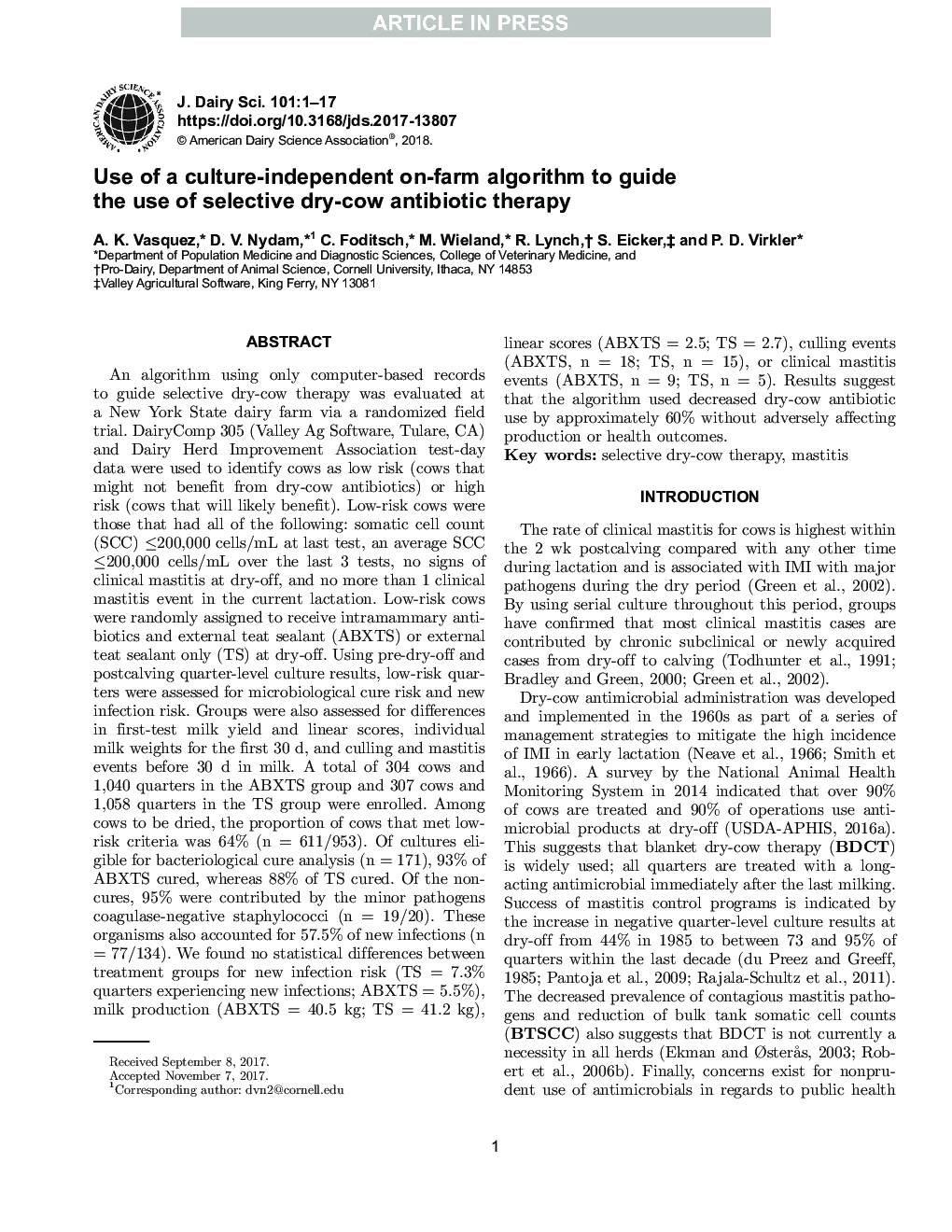| کد مقاله | کد نشریه | سال انتشار | مقاله انگلیسی | نسخه تمام متن |
|---|---|---|---|---|
| 8501161 | 1553839 | 2018 | 17 صفحه PDF | دانلود رایگان |
عنوان انگلیسی مقاله ISI
Use of a culture-independent on-farm algorithm to guide the use of selective dry-cow antibiotic therapy
ترجمه فارسی عنوان
استفاده از یک الگوریتم فرهنگی مستقل در مزرعه برای هدایت استفاده از درمان انتخابی آنتی بیوتیک خشک گاو
دانلود مقاله + سفارش ترجمه
دانلود مقاله ISI انگلیسی
رایگان برای ایرانیان
کلمات کلیدی
درمان انتخابی خشک گاو، ماستیت،
موضوعات مرتبط
علوم زیستی و بیوفناوری
علوم کشاورزی و بیولوژیک
علوم دامی و جانورشناسی
چکیده انگلیسی
An algorithm using only computer-based records to guide selective dry-cow therapy was evaluated at a New York State dairy farm via a randomized field trial. DairyComp 305 (Valley Ag Software, Tulare, CA) and Dairy Herd Improvement Association test-day data were used to identify cows as low risk (cows that might not benefit from dry-cow antibiotics) or high risk (cows that will likely benefit). Low-risk cows were those that had all of the following: somatic cell count (SCC) â¤200,000 cells/mL at last test, an average SCC â¤200,000 cells/mL over the last 3 tests, no signs of clinical mastitis at dry-off, and no more than 1 clinical mastitis event in the current lactation. Low-risk cows were randomly assigned to receive intramammary antibiotics and external teat sealant (ABXTS) or external teat sealant only (TS) at dry-off. Using pre-dry-off and postcalving quarter-level culture results, low-risk quarters were assessed for microbiological cure risk and new infection risk. Groups were also assessed for differences in first-test milk yield and linear scores, individual milk weights for the first 30 d, and culling and mastitis events before 30 d in milk. A total of 304 cows and 1,040 quarters in the ABXTS group and 307 cows and 1,058 quarters in the TS group were enrolled. Among cows to be dried, the proportion of cows that met low-risk criteria was 64% (n = 611/953). Of cultures eligible for bacteriological cure analysis (n = 171), 93% of ABXTS cured, whereas 88% of TS cured. Of the non-cures, 95% were contributed by the minor pathogens coagulase-negative staphylococci (n = 19/20). These organisms also accounted for 57.5% of new infections (n = 77/134). We found no statistical differences between treatment groups for new infection risk (TS = 7.3% quarters experiencing new infections; ABXTS = 5.5%), milk production (ABXTS = 40.5 kg; TS = 41.2 kg), linear scores (ABXTS = 2.5; TS = 2.7), culling events (ABXTS, n = 18; TS, n = 15), or clinical mastitis events (ABXTS, n = 9; TS, n = 5). Results suggest that the algorithm used decreased dry-cow antibiotic use by approximately 60% without adversely affecting production or health outcomes.
ناشر
Database: Elsevier - ScienceDirect (ساینس دایرکت)
Journal: Journal of Dairy Science - Volume 101, Issue 6, June 2018, Pages 5345-5361
Journal: Journal of Dairy Science - Volume 101, Issue 6, June 2018, Pages 5345-5361
نویسندگان
A.K. Vasquez, D.V. Nydam, C. Foditsch, M. Wieland, R. Lynch, S. Eicker, P.D. Virkler,
